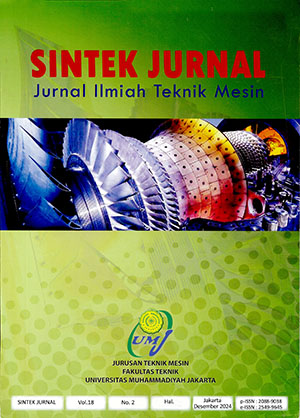The Effect of Variation in Electrode Type and Area on Electrical Productivity of MFC With Sago Stem Substrate
Main Article Content
Abstract
Article Details
- Articles published in SINTEK JURNAL are licensed under a Creative Commons Attribution-ShareAlike 4.0 International license. You are free to copy, transform, or redistribute articles for any lawful purpose in any medium, provided you give appropriate credit to the original author(s) and SINTEK JURNAL, link to the license, indicate if changes were made, and redistribute any derivative work under the same license.
- Copyright on articles is retained by the respective author(s), without restrictions. A non-exclusive license is granted to SINTEK JURNAL to publish the article and identify itself as its original publisher, along with the commercial right to include the article in a hardcopy issue for sale to libraries and individuals.
- By publishing in SINTEK JURNAL, authors grant any third party the right to use their article to the extent provided by the Creative Commons Attribution-ShareAlike 4.0 International license.
References
M. Novriandy, M. Tamjidillah, N. Ramadhan, P. Studi, and T. Mesin, “Pengaruh Mikroorganisme Terhadap Produktivitas Energi Listrik MFC dengan Variasi Limbah Pabrik Tahu dan Limbah Perikanan,” Rotasi, vol. 3, 2021. [Online]. Available: https://ppjp.ulm.ac.id/journals/index.php/rot
S. B. Ardi, “Pemanfaatan Sistem Microbial Fuel Cell (MFC) Menggunakan Bakteri Lactobacillus Plantarum Dengan Substrat Batang Sagu (Metroxylon),” Undergraduate thesis, Universitas Islam Negeri Alauddin Makassar, 2020.
X. A. Walter, E. Madrid, I. Gajda, J. Greenman, and I. Ieropoulos, “Microbial Fuel Cell Scale-up Options: Performance Evaluation of Membrane (c-MFC) and Membrane-less (s-MFC) Systems Under Different Feeding Regimes,” J. Power Sources, vol. 520, 2022. [Online]. Available: https://doi.org/10.1016/j.jpowsour.2021.230875
S. K. Khanal, Anaerobic Biotechnology for Bioenergy Production: Principles and Applications. Wiley-Blackwell, 2008.
A. J. Slate, K. A. Whitehead, D. A. C. Brownson, and C. E. Banks, “Microbial Fuel Cells: An Overview of Current Technology,” Renewable and Sustainable Energy Reviews, vol. 101, pp. 60–81, 2019. [Online]. Available: https://doi.org/10.1016/j.rser.2018.09.044
F. Borja-Maldonado and M. Á. López Zavala, “Contribution of Configurations, Electrode and Membrane Materials, Electron Transfer Mechanisms, and Cost of Components on the Current and Future Development of Microbial Fuel Cells,” Heliyon, vol. 8, no. 7, 2022. [Online]. Available: https://doi.org/10.1016/j.heliyon.2022.e09849
U. Kumari, R. Shankar, and P. Mondal, “Electrodes for Microbial Fuel Cells,” Progress and Recent Trends in Microbial Fuel Cells, pp. 125–141, 2018. [Online]. Available: https://doi.org/10.1016/B978-0-444-64017-8.00008-7
A. Mukimin and H. Vistanty, “Low Carbon Development Based on Microbial Fuel Cells as Electrical Generation and Wastewater Treatment Unit,” Renewable Energy Focus, vol. 44, pp. 132–138, 2023. [Online]. Available: https://doi.org/10.1016/j.ref.2022.12.005
M. I. Ramadhani and A. M. Mursadin, “Pengaruh Variasi Elektroda Tembaga dan Seng Terhadap Produktivitas Listrik Microbial Fuel Cell (MFC) Pada Substrat Limbah Cair Air Rebusan Mie Instan,” Scientific J. Mech. Eng. Kinematika, vol. 5, no. 1, pp. 23–36, 2020. [Online]. Available: https://doi.org/10.20527/sjmekinematika.v5i1.135
M. Ainun and L. Suyati, “Bioelectricity of Various Carbon Sources on Series Circuit from Microbial Fuel Cell System Using Lactobacillus plantarum,” J. Kim. Sains & Aplikasi, vol. 4, pp. 70–74, 2018.
A. A. Yaqoob, M. N. M. Ibrahim, M. Rafatullah, Y. S. Chua, A. Ahmad, and K. Umar, “Recent Advances in Anodes for Microbial Fuel Cells: An Overview,” Materials, vol. 13, no. 9, 2020. [Online]. Available: https://doi.org/10.3390/ma13092078
N. Rahmah, M. R. Kirom, and A. Riu, “Analisis Pengaruh Panjang Jembatan Garam Terhadap Produksi Listrik Pada Dual Chambar MFC,” E-Proceeding Eng., vol. 7, pp. 9247–9254, 2020.
R. Widiana, “Pemanfaatan Batang Pisang Sebagai Substrat Dalam Teknologi Microbial Fuel Cell (MFC) Menggunakan Lactobacillus Plantarum,” Undergraduate thesis, Universitas Islam Negeri Alauddin Makassar, 2020.
Kementan RI, Statistik Perkebunan Unggulan Nasional 2020-2022. Direktorat Jendral Perkebunan Kementrian Republik Indonesia, 2022.
Rahmaniah, S. B. Ardi, and N. Fuadi, “Aplikasi Teknologi Microbial Fuel Cell (MFC) Untuk Menentukan Energi Listrik Substrat Batang Sagu (Metroxylon),” J. Teknosains, vol. 14, no. 2, pp. 172–175, 2020.
M. A. Fitri, “Pengaruh Variasi Elektrode dan Substrat Limbah Buah Terhadap Power Density pada Microbial Fuel Cell dari Air Gambut,” Undergraduate thesis, Universitas Lambung Mangkurat, 2022.
B. Ibrahim, P. Suptijah, and S. Rosmalawati, “Kinerja Rangkaian Seri Sistem Microbial Fuel Cell Sebagai Penghasil Biolistrik Dari Limbah Cair Perikanan,” JPHPI, vol. 17, 2014.
U. Sholikah, N. Alfian, M. Kamaluddin, and A. Prasetyo, “Sumber Energi Alternatif Rumput Vetiver Dengan Metode Plant Microbial Fuel Cell,” in Proc. SNRT Politeknik Negeri Banjarmasin, 2019.
D. H. Sinaga, L. Sayuti, and A. L. N. Aminin, “Studi Pendahuluan Pemanfaatan Whey Tahu sebagai Substrat dan Efek Luas Permukaan Elektroda dalam Sistem Microbial Fuel Cell,” J. Sains Dan Matematika, vol. 22, pp. 30–35, 2014.
A. M. Helmenstine, “Table of Electrical Resistivity and Conductivity,” ThoughtCo., June 2019. [Online]. Available: https://www.thoughtco.com/table-of-electrical-resistivity-conductivity-608499


